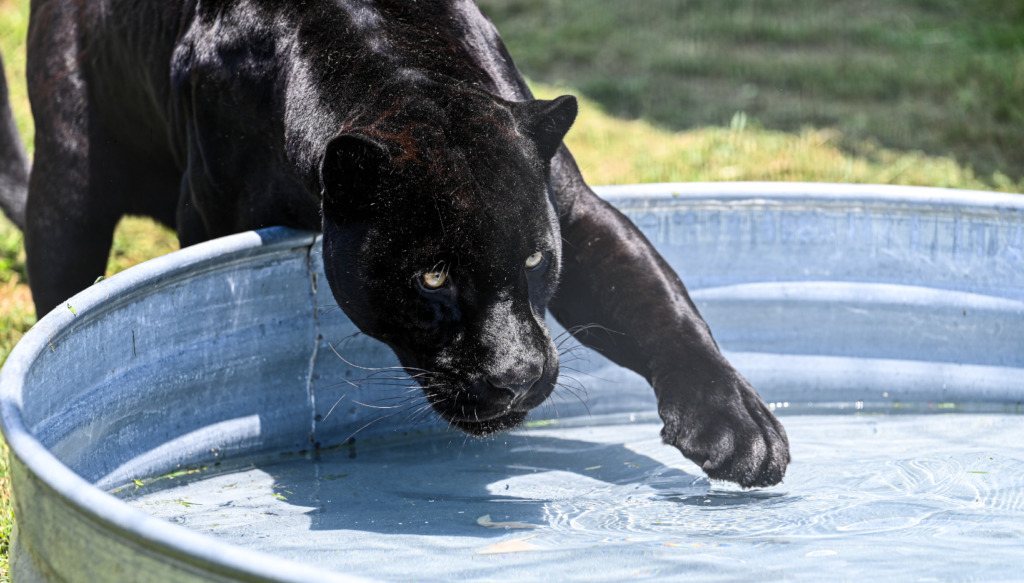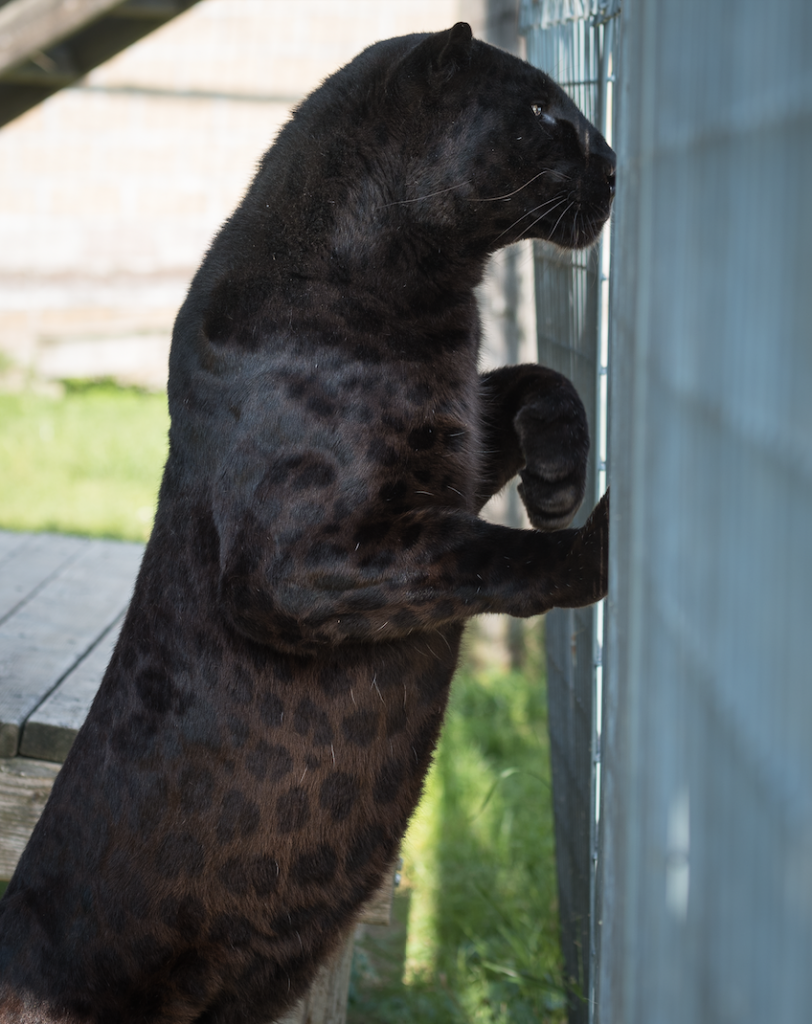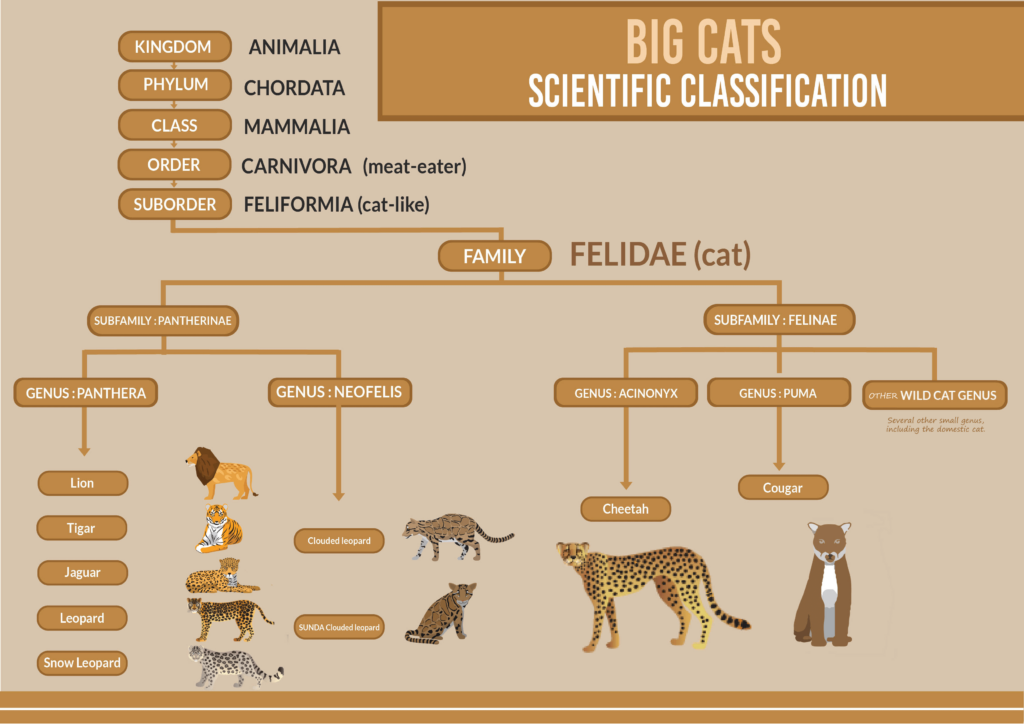
At Turpentine Creek Wildlife Refuge, we are passionate about providing proper wildlife education, unraveling the mysteries of the animal kingdom, and dispelling myths that surround our magnificent feline friends. One such myth that has captured the imagination of many, especially in pop culture, is the elusive and enigmatic “black panther.” Contrary to popular belief, no distinct species is called a black panther. Instead, these mystical creatures are, in fact, melanistic leopards (Panthera pardus) and jaguars (Panthera onca), their dark coats concealing a world of wonder and intrigue.
The term “panther” creates further confusion for animal enthusiasts because it is one of many names for a cougar (Puma concolor). This North American big cat holds the Guinness Book of World Records for the most common names, including cougar, mountain lion, puma, panther, catamount, and many more.

The Mystique of the Black Panther:
The term “black panther” has long been used to describe large, shadowy cats that seem to emerge from the depths of the jungle, embodying a sense of mystery and magic. However, the reality is far less fantastical. Black panthers are not a unique species but rather a captivating manifestation of melanism, a genetic condition that results in an excess of dark pigmentation in the skin and fur. In the jungle, having a darker coat for camouflage than it would be in the grassy savanna is highly advantageous.
Melanistic Leopards:
In the jungles of Africa and Asia, melanistic leopards, also known as black leopards, silently stalk their prey, their sleek, obsidian coats providing them with a distinct advantage in the shadows. The black coloration of their fur results from a surplus of melanin, the pigment responsible for skin and hair color in animals.
Black leopards are essentially the same species as their more commonly spotted counterparts. Though challenging to see their spots against the dark background, they are still present and visible under certain lighting conditions. At Turpentine Creek Wildlife Refuge, we have been fortunate to welcome black leopards into our sanctuary, allowing us to appreciate their unique beauty up close.
Melanistic Jaguars:
A parallel phenomenon occurs among jaguars in the dense rainforests of the Americas. Melanistic jaguars have a jet-black coat adorned with the occasional hint of rosettes, the distinctive spots characteristic of their non-melanistic kin. Much like black leopards, these majestic creatures are not a separate species but rather a testament to the wonders of genetic diversity.
Conservation Significance:
Understanding the truth behind the myth of the black panther is not only fascinating but also crucial for conservation efforts. By appreciating the diversity within species, we can better protect these magnificent cats and their habitats. Melanism is just one of the many natural variations that contribute to the resilience and adaptability of these feline predators.
At Turpentine Creek Wildlife Refuge, our commitment to the well-being of big cats extends beyond the confines of myth-busting. We strive to provide a haven for these majestic creatures, offering them the care and respect they deserve. Through education and awareness, we hope to inspire a deeper understanding of the intricacies of the animal kingdom and foster a sense of responsibility for the conservation of all wildlife.
Because of their mystical and exotic appearance, black leopards and jaguars were highly sought after in the exotic pet trade. It is expected to see many of them in accredited sanctuaries throughout the United States, having been rescued from previous situations of abuse, neglect, show business, and breeding facilities.
The myth of the black panther may have captivated imaginations for centuries, but the reality is no less enchanting. Melanistic leopards and jaguars, with their inky coats and powerful presence, remind us of the awe-inspiring diversity within the natural world. As we continue our mission at Turpentine Creek Wildlife Refuge, we invite you to join us in celebrating the truth behind the myth and appreciating these magnificent creatures for the wonders they truly are.

